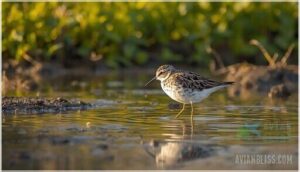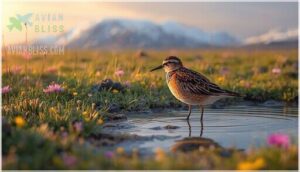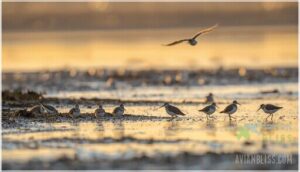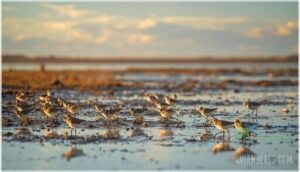This site is supported by our readers. We may earn a commission, at no cost to you, if you purchase through links.
 You’ll find the Least Sandpiper racing across mudflats on legs so yellow they seem to glow against brown sediment—a field mark no other North American peep shares. This pocket-sized shorebird, barely longer than your smartphone, executes intercontinental migrations that dwarf its 13-centimeter frame, traveling from Arctic tundra to South American wetlands with precision that humbles our most advanced GPS systems.
You’ll find the Least Sandpiper racing across mudflats on legs so yellow they seem to glow against brown sediment—a field mark no other North American peep shares. This pocket-sized shorebird, barely longer than your smartphone, executes intercontinental migrations that dwarf its 13-centimeter frame, traveling from Arctic tundra to South American wetlands with precision that humbles our most advanced GPS systems.
Despite spanning 60 degrees of latitude and covering distances that would exhaust birds ten times its size, this species faces a quiet decline, losing one-third of one percent of its population annually since 1970.
Understanding how to identify this diminutive traveler, where it feeds during its marathon journeys, and what threatens its ancient migratory routes reveals both the resilience of small-bodied shorebirds and the fragility of the wetland networks they depend on.
Table Of Contents
- Key Takeaways
- Least Sandpiper Identification
- Habitat and Geographic Range
- Migration Patterns and Behavior
- Diet and Foraging Techniques
- Conservation Status and Threats
- Frequently Asked Questions (FAQs)
- What is the difference between a sandpiper and a Least Sandpiper?
- Why is it called the Least Sandpiper?
- What is the Least Sandpiper in flight?
- Where do Least Sandpipers live?
- What differentiates least sandpipers from other sandpipers?
- How do least sandpipers communicate with each other?
- What is the typical lifespan of a least sandpiper?
- How do weather changes affect least sandpipers?
- Do least sandpipers exhibit flocking behavior during migration?
- How do Least Sandpipers communicate with each other?
- Conclusion
Key Takeaways
- The Least Sandpiper—North America’s smallest shorebird at just 13-15 cm—completes intercontinental migrations exceeding 5,000 miles between Arctic breeding grounds and South American wintering areas, powered by physiological adaptations that enable 30% body mass in fat reserves and nonstop transoceanic flights of 1,800-2,500 miles despite weighing under 30 grams.
- Diagnostic field identification hinges on distinctive yellowish-green legs (unique among North American “peeps”), a fine-tipped slightly downcurved bill, hunched feeding posture on drier mudflat edges rather than wading zones, and compact size noticeably smaller than similar sandpipers when viewed in mixed flocks.
- Population decline of 0.33% annually since 1970—with eastern Canada experiencing drops up to 15.8%—stems from compounding threats including wetland habitat loss affecting 40% of intertidal stopover zones, climate-driven Arctic breeding range shifts of 11-20 km per decade, and prey base reductions of 30-45% from eutrophication despite current “Least Concern” IUCN status.
- These shorebirds function as ecosystem engineers in wetland habitats by aerating sediment to 1.2 cm depth during foraging, increasing invertebrate biodiversity by 60%, suppressing mosquito larvae populations by 40%, and demonstrating remarkable site fidelity (75%) to proven stopover locations that underscores the critical importance of protecting interconnected wetland networks across migration flyways.
Least Sandpiper Identification
When you spot a tiny sandpiper working the mudflats, you’ll want to nail down the ID fast before it vanishes into the flock.
The Least Sandpiper may be sparrow-sized, but it packs enough distinctive features to separate it from its look-alike cousins. Here’s what to watch for in the field.
Size and Shape Compared to Other Sandpipers
You’ll spot this sandpiper species by its compact structure—it’s the smallest of all, measuring just 13–15 cm with a 27–28 cm wingspan. Body proportions reveal shorter necks and legs than its relatives, creating that hunched appearance in mudflats.
Morphology sets it apart from Semipalmated Sandpiper and Western Sandpipers, which outweigh it by 12–25%. The wing aspect ratio of 4.6 powers efficient long-distance flight despite its diminutive size.
The species’ distinctive features can be further understood through shorebird identification guides.
Distinctive Bill and Leg Coloration
Your eyes will catch the fine-tipped bill structure first—a slim, slightly downcurved black probe measuring 13–16 mm, perfect for extracting invertebrates from soft substrate. But here’s the clincher: yellowish legs that set this species apart from black-legged relatives.
That leg pigmentation, driven by biliverdin derivatives, has dual purposes—camouflage strategies in vegetated wetlands and thermoregulation through heat dissipation. Mud often obscures this diagnostic trait, though, complicating field identification in roughly 27% of observations.
These birds, also known as “small sandpipers“, are often difficult to identify.
Plumage Patterns and Seasonal Variations
Breeding plumage transforms these tundra wanderers into rufous-toned marvels—rich reddish-brown and black upperparts with heavily streaked breasts appear from May through July, coinciding with Arctic nesting. Non-breeding plumage shifts to subdued grayish-brown by October as molting cycles complete on southern wintering grounds.
Geographic variation emerges as western populations molt earlier than eastern birds, with coloration mechanisms driven by melanin distribution and carotenoid expression controlling those diagnostic tonal shifts you’ll track across seasons.
Differences Between Adults and Juveniles
As plumage shifts with the seasons, you’ll notice age-based differences that reveal each bird’s story. Juveniles arrive at staging areas 5–10 days behind adults, sporting brighter rusty-edged feathers and finer bills—measurements show 65% of juvenile sandpipers display less sturdy bill structure during fall migration.
- Juveniles retain abraded, buffy-edged median coverts through their first winter while adults molt into fresh plumage
- Leg coloration appears paler on young birds before intensifying after their first prebasic molt
- Bill development shows lighter bases in 78% of juveniles before full maturation occurs
- Metabolic rates run 27–36% higher in juveniles due to increased exploration and lower site fidelity
- Migration timing separates age classes, with juveniles departing breeding grounds two weeks later than experienced adults
Key Features for Field Identification
When scanning mudflats or marsh edges, you’ll lock onto several key traits that clinch your Least Sandpiper identification. Size comparison reveals this species as the smallest shorebird you’ll encounter—noticeably more compact than Western or Semipalmated Sandpipers in mixed flocks. The bill shape appears slim and slightly drooping with a fine-tipped bill that distinguishes it from blunter-billed peeps, while leg color remains consistently yellowish-green regardless of plumage variations. Flight patterns showcase a thin white wing stripe against darker underwings, and you’ll notice hunched feeding postures on drier mudflat edges rather than wading zones.
| Feature | Least Sandpiper | Similar Species |
|---|---|---|
| Size | 5.1-5.9 inches; 0.7-1.1 oz | Semipalmated: 5.5-6.3 inches |
| Bill | Slim, decurved, fine-tipped | Western: heavier, longer droop |
| Legs | Yellowish-green, unwebbed toes | Semipalmated/Western: black legs |
| Breast | Brown wash contrasting white belly | Pectoral: sharper demarcation |
| Foraging | Hunched on drier mud edges | Western: wades in shallow water |
Habitat and Geographic Range
The Least Sandpiper doesn’t play by the rules of coastal living alone—you’ll find this adaptable shorebird thriving from mudflats to marshes, from Arctic breeding grounds to tropical wintering shores.
Understanding where these birds show up throughout the year reveals how they’ve mastered diverse environments across two continents. Let’s explore the habitats and range that define this sandpiper’s notable geographic footprint.
Preferred Coastal and Inland Wetlands
You’ll find Least Sandpipers in a spectrum of coastal and wetland habitats, from sheltered mudflat substrates to inland stopovers along migration routes. Wetland salinity tolerance is broad—they occupy fresh to brackish environments up to 25 ppt—while hydrological factors like shallow water depth (under 20 mm) and fine silt-clay substrates drive habitat preferences across coastal lagoons, flooded fields, and wetland ecosystems.
- Coastal refuges: Tidal creeks, saltmarshes, and mangrove-fringed lagoons shelter migrating and wintering populations
- Inland oases: Flooded agricultural fields, sewage ponds, and ephemeral wetlands provide critical stopover sites
- Substrate selectivity: Fine mud with 40–70% moisture hosts twice the density found on coarse sand
Breeding Grounds in Northern North America
Each May through early June, you’ll witness Least Sandpiper nesting habitat spanning 6 million square kilometers from western Alaska to Newfoundland—moist tundra, sedge meadows, and boreal bogs where over 80% of the global population breeds.
Canada hosts approximately 1.8 million breeding individuals across these subarctic zones, with nesting timing synchronized to snowmelt advances that have shifted 6–10 days earlier per decade since the 1980s.
Climate impacts threaten 25–40% of alpine breeding habitat by 2100, making population distribution monitoring a conservation priority as warming accelerates forest encroachment and reduces low-lying coastal tundra nesting sites by 15% since 1995.
Wintering Areas in The Americas
You’ll discover wintering Least Sandpipers dispersed across 60 degrees of latitude—from southern Oregon to Brazil—occupying mudflats, mangrove swamps, and flooded pastures from late August through May. Central America sustains 120,000–150,000 individuals, while northeastern South America hosts 80,000–100,000 in coastal systems.
Population density peaks between December and February, with migration patterns showing 75% site fidelity. Ecological conditions like sediment organic content correlate strongly with wintering concentrations, though habitat degradation has reduced suitable nonbreeding distribution areas by 18% since 2000, creating conservation challenges.
Adaptations to Varied Environments
You’ll find Least Sandpipers equipped with striking morphological adaptations, physiological adaptations, and behavioral adaptations that enable survival across diverse wetlands—from Arctic tundra to tropical mudflats. Their 17–20 mm decurved bill excels at precision probing in fine sediments, while yellowish legs stabilize movement on soft substrates. Climate adaptations include salt glands excreting excess sodium in saline habitats, and lipid reserves reaching 30% of body mass fuel nonstop migrations exceeding 900 km.
- Habitat Preferences shift with conditions: stopover durations average 4 days when water levels foster foraging efficiency
- Least Sandpiper feeding habits adjust to thermal stress: nocturnal foraging increases 35% during extreme daytime heat
- Climate Change Impacts on Birds drive phenological shifts: arrivals now occur 4–6 days earlier than 1980s baselines, tracking temperature increases
Migration Patterns and Behavior
Understanding the Least Sandpiper’s migration patterns reveals the impressive journeys these tiny shorebirds undertake twice each year. Their routes span thousands of miles, connecting breeding grounds in the far north with wintering areas across the Americas.
You’ll find their behavior shifts with the seasons, from nonstop ocean crossings to strategic inland stops, making them one of the more adaptable migrants in the sandpiper family.
Spring and Fall Migration Routes
You’ll track Least Sandpipers across dramatic journeys spanning thousands of miles through four distinct flyways. Eastern populations often take audacious transoceanic flights—nonstop crossings of 1,800 to 2,500 miles directly to South America—while western birds navigate inland corridors with shorter hops and frequent stops.
Least Sandpipers embark on dramatic transoceanic flights—nonstop crossings up to 2,500 miles—while western populations prefer inland routes with strategic stops
Spring migration patterns unfold from late March through mid-June, peaking in early May, while fall movements stretch from late June through November, with adults departing breeding grounds first and juveniles following weeks later.
| Season | Migration Characteristics |
|---|---|
| Spring | Begins late March; peaks early May; reaches breeding grounds by mid-June using Atlantic, Mississippi, Central, and Pacific flyways |
| Fall | Adults depart late June; juveniles peak August-September; routes span over 5,000 miles to wintering grounds in Central and South America |
Stopover Sites and Migration Strategies
During those epic journeys, you’ll find Least Sandpipers strategically selecting stopover sites—both coastal and inland—where shallow water meets exposed mud. Adults generally refuel for just 4 days, while juveniles linger over 6 days, building energy reserves.
These birds show striking stopover site fidelity, returning to proven locations year after year, favoring inland habitats like flooded fields and marsh edges where invertebrate prey thrives and migration energy expenditure stays manageable.
Flocking and Roosting Habits
Once birds refuel, they gather into small, strategic flocks—usually 20 to 80 individuals—mixing with Western Sandpipers and Dunlins on coastal mudflats. You’ll spot them roosting at high tide on barren levees or vegetated marsh edges, staying 45 to 60 minutes before returning to forage.
Their roost selection hinges on minimal human disturbance and low vegetation, reflecting environmental influences that shape shorebirds’ feeding behavior and habitat use vital for conservation.
Seasonal Behavioral Changes
Between stopover flights and breeding grounds, you’ll witness dramatic Seasonal Shifts in their Behavior. Physiological Changes and Hormonal Responses drive Behavioral Adaptations: diurnal feeding behavior shifts to nocturnal migration, territorial aggression erupts during breeding behavior, and diet transitions from dipteran larvae on tundra to coastal amphipods.
Males guard territories while plasma corticosterone surges fuel fat deposition—Migratory Patterns shaped by internal clocks and environmental cues governing survival itself.
Diet and Foraging Techniques
The Least Sandpiper’s diet reflects its adaptability across diverse wetland habitats throughout its annual cycle.
You’ll find these tiny foragers employing specialized techniques to extract invertebrates from mud and sand with striking efficiency.
Understanding their feeding ecology reveals how they’ve carved out a unique niche among North American shorebirds.
Primary Food Sources
You’ll find the Least Sandpiper’s diet shifts like a traveler’s menu, adapting to whatever fuels the next leg of the journey. Aquatic invertebrates—chironomid larvae, beetles, amphipods—dominate their intake during migration and breeding, while biofilm can provide up to 59% of caloric needs at coastal stopovers. When invertebrates dwindle, seeds from marsh grasses fill the gap.
- Chironomid larvae fuel up to 77% of fall migration diets at key stopover sites
- Biofilm delivers critical energy reserves on intertidal flats
- Crustaceans and snails compose roughly 30% of coastal foraging intake
Feeding Behaviors and Foraging Methods
Watch them crouch low, legs bent, taking deliberate steps across exposed mud at a pace of 1.2 meters per minute—this hunched posture defines their foraging strategy.
You’ll observe rapid pecking (35–45 actions per minute) alternating with shallow probing, as mechanoreceptors in the bill tip detect invertebrates within milliseconds.
They favor soft sediments less than 2 cm deep, capturing prey at rates reaching 8 items per minute when tidal conditions expose prime feeding zones during low tide.
Seasonal Dietary Changes
Your understanding of their diet deepens when you track seasonal transitions—fly larvae dominate breeding grounds at over 60%, while coastal winters trigger dramatic dietary shifts where polychaete worms exceed 80% of biomass intake.
Migration stopovers reveal adaptive foraging strategies, with crustacean and snail consumption climbing to 35% as nutrient acquisition demands intensify before long-distance flights.
Role in Wetland Ecosystems
You’re witnessing ecosystem engineering firsthand—these shorebirds aerate sediment up to 1.2 cm deep during foraging, boosting nutrient cycling and creating oxygen-rich zones that increase invertebrate biodiversity by 60% in wetland habitats.
Their prey removal shapes coastal ecosystems, suppressing mosquito larvae by 40% while maintaining trophic balance.
Conservation status depends on protecting these essential habitat preferences, as declining populations signal broader wetland maintenance failures affecting ecosystem services we can’t afford to lose.
Conservation Status and Threats
The Least Sandpiper’s future isn’t set in stone—it depends on how we respond to mounting pressures. While the species currently holds “Least Concern” status, populations face real threats that demand your attention.
Here’s what you need to know about the challenges ahead and the efforts working to protect these tiny travelers.
Current Population Trends
The Least Sandpiper population faces a quiet decline—long-term surveys show a 0.33% annual drop across North America since 1970, with species abundance declining 3% over 15 years. Eastern Canada is hit hardest, where migration patterns reflect localized reductions up to 15.8%.
Despite IUCN status listing it as Least Concern, breeding success rates and population decline trends signal that conservation efforts need sharpening before this tiny wanderer slips further.
Impacts of Habitat Loss and Climate Change
You’ll witness habitat loss and climate change rewriting the Least Sandpiper’s survival playbook. Coastal ecosystems that once sustained thousands now buckle under pressure, while warming Arctic zones shift breeding grounds northward—forcing these travelers into uncharted territory.
Key threats include:
- Wetland Habitat Degradation: Eastern Canada saw 15.8% annual population drops (1974–1998) as coastal development destroyed stopover sites—up to 40% of intertidal zones now face sea level rise inundation.
- Breeding Range Climate Shifts: Arctic warming pushes nesting grounds northward at 11–20 km per decade, with models projecting 25–35% habitat contraction by 2070.
- Migration Stopover Collapse: Rising seas threaten 23–40% of critical refueling sites, while habitat fragmentation cuts migratory success by 72% along degraded routes.
- Ecosystem Disruption of Prey: Wetland eutrophication slashed preferred invertebrate abundance 30–45% since 2000, forcing longer foraging times and reduced feeding efficiency.
- Biodiversity Loss Cascade: Combined stressors could reduce global range viability 40% this century—North American populations may decline 26% by 2050 without intervention.
Conservation Measures and Protections
You’ll find protection woven into legal frameworks that span continents. The Migratory Bird Treaty Act (1918) and Canada’s Migratory Birds Convention Act safeguard Least Sandpipers across borders, while the Western Hemisphere Shorebird Reserve Network secures 100+ critical sites through 13 countries—conservation efforts grounded in species protection and environmental policies.
Habitat restoration programs under NAWCA have enhanced 3.6 million acres since 1991, directly supporting wetland conservation and migration safeguards.
These shorebird conservation status measures deliver measurable results: continental populations holding steady near 700,000 individuals, though threats to population persist in eastern regions.
Ongoing Research and Monitoring Efforts
Protection frameworks gain power through data—and that’s where research transforms policy into action. Scientists now deploy satellite tracking, habitat modeling, and climate monitoring to quantify threats and guide shorebird conservation status assessments across migration patterns spanning hemispheres.
You’ll discover how conservation and bird conservation merge through ornithology:
- Motus towers capture 12,000+ tracking records, revealing nonstop Caribbean flights and stopover survival tactics
- eBird’s citizen science army logs millions of observations, aligning migration timing with 90% telemetry accuracy
- Landsat scans 1,500+ scenes since 2013, identifying California wetlands critical for survival
- Adaptive habitat modeling predicts 9% northward breeding shifts by 2040, directing preemptive restoration investments
Frequently Asked Questions (FAQs)
What is the difference between a sandpiper and a Least Sandpiper?
Sandpiper acts as a sweeping term for dozens of shorebird species, while the Least Sandpiper stands as the smallest—measuring just 5-6 inches and weighing under 30 grams, with distinctive yellowish legs and a slightly downcurved bill.
Why is it called the Least Sandpiper?
You’ll recognize this species by its status as North America’s smallest sandpiper—measuring just 5–9 inches.
The name “Least” directly references its tiny stature, distinguishing it from larger relatives through taxonomy classification and species naming conventions established in ornithological etymology history.
What is the Least Sandpiper in flight?
Like a swift arrow darting across wetland skies, you’ll recognize this bird by its rapid wingbeats—about 18 per second—and compact silhouette. Aerial displays feature zigzag flight patterns during breeding, while migration routes showcase extraordinary endurance with nonstop flights spanning 2,500 miles at speeds around 75-83 km/h.
Where do Least Sandpipers live?
You’ll find these birds across diverse wetland ecosystems and coastal habitats spanning from Arctic breeding grounds to South American shores.
Their geographic range extends from northern tundra and boreal bogs during summer to mudflats and saltmarshes along migration routes and wintering areas, demonstrating exceptional habitat preferences across hemispheres.
What differentiates least sandpipers from other sandpipers?
You’ll spot this species by its tiny frame—the smallest sandpiper around—plus yellowish-green legs, a fine-tipped bill that curves slightly downward, and brownish plumage that sets it apart from black-legged relatives, especially when foraging inland during migration.
How do least sandpipers communicate with each other?
Vocal displays dominate during breeding—males deliver high-pitched creeps, rich trills, and rhythmic songs while spiraling through aerial courtship flights.
Visual signals like wing-up postures and shuffling approaches reinforce territorial defense and mate attraction through coordinated social interactions.
What is the typical lifespan of a least sandpiper?
Every migration is a gamble with mortality rates—yet some sandpipers defy the odds. Wild least sandpipers usually survive 7-10 years, though banding records document remarkable individuals reaching 16-17 years.
Juveniles face higher annual mortality (~28%) than adults (~20%), with survival strategies and longevity records shaped by predation, disease, and habitat quality throughout their lifecycle.
How do weather changes affect least sandpipers?
Climate change impacts migration timing, breeding success, and stopover habitat availability. Storm effects destroy nesting sites, while temperature shifts alter wetland conditions.
Habitat disruption from weather patterns forces route adjustments, straining coastal ecosystems and threatening conservation status.
Do least sandpipers exhibit flocking behavior during migration?
Migration patterns reveal fascinating group dynamics—you’ll find these tiny shorebirds traveling in small flocks of 3-10 individuals during spring and fall journeys.
Stopover ecology shows they frequently join mixed-species assemblages with other sandpipers, enhancing predator detection and foraging efficiency through social behavior adaptations.
How do Least Sandpipers communicate with each other?
Shorebirds use bird vocalizations and visual displays to stay connected and survive. You’ll hear high-pitched creep calls keeping flocks together, while alarm calls warn of danger.
Males perform aerial dives with songs and calls during breeding, strengthening social bonding through synchronized flight patterns.
Conclusion
Good things come in small packages, and the least sandpiper proves this adage with every tundra-to-tropics journey it completes. Your ability to spot those signature yellow legs on mudflats, recognize its high-pitched kreet calls at coastal stopovers, and understand the wetland corridors it depends on transforms casual observation into conservation awareness.
Each sighting connects you to migratory pathways older than human civilization—routes now threatened by habitat fragmentation and climate shifts. Protecting this diminutive wanderer means safeguarding the interconnected wetlands that sustain countless species across two continents.
- https://travisaudubon.org/murmurations/bird-of-the-week-least-sandpiper
- https://www.nzbirdsonline.org.nz/species/least-sandpiper
- https://www.tandfonline.com/doi/full/10.1080/10402381.2021.1920071
- https://www.allaboutbirds.org/guide/Least_Sandpiper/lifehistory
- https://www.savecoastalwildlife.org/save-coastal-wildlife-blog/2019/6/11/shorebirds-in-decline












